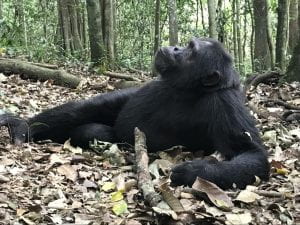Primate Conservation in the Pearl of Africa


My sophomore year of undergrad at Cornell, I applied on a whim to Hunter College’s winter break study abroad program with Dr. Jessica Rothman, a primatologist in the Anthropology Department at Hunter. I have been passionate about wildlife since childhood. Even as a toddler, I would stare unblinkingly at my safari motion lamp, watching the elephants, giraffes, and lions strut in an endless loop and dreaming of the day that I would see them for myself. When I was admitted into the program, my dream was coming true.

It’s no secret that there is a danger in setting high expectations. In the weeks leading up to my 2018 trip to Uganda, I had ample time to question whether my study abroad experience could possibly live up to my hopes. And I can’t count the number of times I screamed at the television in horror in the week before my trip, as the Weather Channel heralded the arrival of Winter Storm Grayson, the bomb cyclone that slammed the East Coast two days before my departure from JFK Airport. Pre-trip jitters aside, I can say with tremendous gratitude that this trip managed to exceed my already sky high expectations. This experience lent me an educated view of the nuanced complexities of conservation.
The course, Tropical Forest Conservation, was primarily geared towards field research, so we spent time learning how to identify flora and fauna in the forest, how to track primates as they moved throughout the forest, and how to best observe them in Kibale National Park. This first leg of the trip allowed me to see a range of species in their natural habitats and to see for myself the ecological diversity present in the park that makes its protection essential. I also gained a better understanding of the unique opportunities and challenges associated with field work.
The second leg of the trip in Queen Elizabeth Park consisted of game drives, during which we saw lions, elephants, warthogs, hippos, African buffalo, and more. Seeing these species for myself was definitely among my favorite parts of the trip. However, throughout the course, we also heard lectures from various conservation workers in Uganda, from researchers to members of the Uganda Wildlife Authority. I had the chance to hear firsthand about some of the challenges of conservation and to understand the complexities of achieving lasting change. Before this course, I saw the challenges to conservation as being quite simple. I imagined those who would seek to harm animals as movie-style villains, all but swathed in black capes. The narrative is certainly riddled with villainy, but I now know just how many complicating factors there are. Many people in Uganda have complex relationships with their native wildlife because the animals are inadvertently hindering their way of life. A single elephant can consume in one night the crops that would feed a family for a year. Wild animals can at times pose a threat to the livelihoods of local people, so asking them to help conserve their wildlife is more complicated than I had initially thought.

I was so intrigued by the challenges to conservation that months after my trip, I interviewed Dr. Colin Chapman, a professor in the Anthropology Department at McGill University, Canada Research Chair in Primate Ecology and Conservation, and the head of the Kibale Monkey Project in Uganda about his conservation and humanitarian work. Dr. Chapman’s extensive research work around the globe has lent him a unique perspective on how to best promote an interest in conservation. He told me that “Almost everywhere the local people want to conserve. There’s a real pride in their forests and their animals. When they don’t conserve, it’s mostly because they feel they don’t have a choice. If you have to cut down a tree to send your children to school, what’s your choice? I think that’s the thing that I’ve found around the world and I find it really positive. If we can provide things that make life a little bit easier, it’s basically going to mean that there’s a big will to conserve.” My own experience in Uganda led me to similar conclusions. Dr. Chapman’s efforts to improve park-people interactions have already yielded positive results. (For more information, I recommend visiting Dr. Chapman’s website: http://www.chapmancolin.com/ ).
The issues surrounding conservation are so multi-faceted, they will require an equally complex approach to solving them. My trip to Uganda and the conversations that ensued were a tremendous learning experience for me. Through my different conservation and wildlife medicine related experiences, I have met so many different people with different backgrounds, opinions, and skill sets. What unifies them is a passion for conservation and a drive to support animal populations and their environment, and, in doing so, better the human experience.

Colleen Sorge, class of 2024, is a Cornell DVM student from Long Island, NY. She obtained her undergraduate degree in Animal Science from Cornell University in 2020. She has a wide range of interests within the veterinary field, including both small animal and wildlife medicine.

